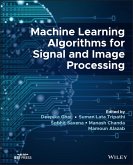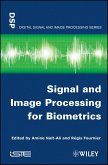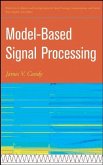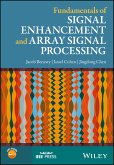Todd A. Ell, Nicolas Le Bihan, Stephen J. Sangwine
Quaternion Fourier Transforms for Signal and Image Processing (eBook, PDF)
139,99 €
139,99 €
inkl. MwSt.
Sofort per Download lieferbar

0 °P sammeln
139,99 €
Als Download kaufen

139,99 €
inkl. MwSt.
Sofort per Download lieferbar

0 °P sammeln
Jetzt verschenken
Alle Infos zum eBook verschenken
139,99 €
inkl. MwSt.
Sofort per Download lieferbar
Alle Infos zum eBook verschenken

0 °P sammeln
Todd A. Ell, Nicolas Le Bihan, Stephen J. Sangwine
Quaternion Fourier Transforms for Signal and Image Processing (eBook, PDF)
- Format: PDF
- Merkliste
- Auf die Merkliste
- Bewerten Bewerten
- Teilen
- Produkt teilen
- Produkterinnerung
- Produkterinnerung

Bitte loggen Sie sich zunächst in Ihr Kundenkonto ein oder registrieren Sie sich bei
bücher.de, um das eBook-Abo tolino select nutzen zu können.
Hier können Sie sich einloggen
Hier können Sie sich einloggen
Sie sind bereits eingeloggt. Klicken Sie auf 2. tolino select Abo, um fortzufahren.

Bitte loggen Sie sich zunächst in Ihr Kundenkonto ein oder registrieren Sie sich bei bücher.de, um das eBook-Abo tolino select nutzen zu können.
Based on updates to signal and image processing technology made in the last two decades, this text examines the most recent research results pertaining to Quaternion Fourier Transforms. QFT is a central component of processing color images and complex valued signals. The book's attention to mathematical concepts, imaging applications, and Matlab compatibility render it an irreplaceable resource for students, scientists, researchers, and engineers.
- Geräte: PC
- mit Kopierschutz
- eBook Hilfe
- Größe: 7.71MB
Andere Kunden interessierten sich auch für
![Quaternion Fourier Transforms for Signal and Image Processing (eBook, ePUB) Quaternion Fourier Transforms for Signal and Image Processing (eBook, ePUB)]() Todd A. EllQuaternion Fourier Transforms for Signal and Image Processing (eBook, ePUB)139,99 €
Todd A. EllQuaternion Fourier Transforms for Signal and Image Processing (eBook, ePUB)139,99 €![Regularization and Bayesian Methods for Inverse Problems in Signal and Image Processing (eBook, PDF) Regularization and Bayesian Methods for Inverse Problems in Signal and Image Processing (eBook, PDF)]() Regularization and Bayesian Methods for Inverse Problems in Signal and Image Processing (eBook, PDF)139,99 €
Regularization and Bayesian Methods for Inverse Problems in Signal and Image Processing (eBook, PDF)139,99 €![Machine Learning Algorithms for Signal and Image Processing (eBook, PDF) Machine Learning Algorithms for Signal and Image Processing (eBook, PDF)]() Machine Learning Algorithms for Signal and Image Processing (eBook, PDF)123,99 €
Machine Learning Algorithms for Signal and Image Processing (eBook, PDF)123,99 €![Signal and Image Processing for Biometrics (eBook, PDF) Signal and Image Processing for Biometrics (eBook, PDF)]() Signal and Image Processing for Biometrics (eBook, PDF)140,99 €
Signal and Image Processing for Biometrics (eBook, PDF)140,99 €![Model-Based Signal Processing (eBook, PDF) Model-Based Signal Processing (eBook, PDF)]() James V. CandyModel-Based Signal Processing (eBook, PDF)183,99 €
James V. CandyModel-Based Signal Processing (eBook, PDF)183,99 €![Advanced Digital Signal Processing and Noise Reduction (eBook, PDF) Advanced Digital Signal Processing and Noise Reduction (eBook, PDF)]() Saeed V. VaseghiAdvanced Digital Signal Processing and Noise Reduction (eBook, PDF)116,99 €
Saeed V. VaseghiAdvanced Digital Signal Processing and Noise Reduction (eBook, PDF)116,99 €![Fundamentals of Signal Enhancement and Array Signal Processing (eBook, PDF) Fundamentals of Signal Enhancement and Array Signal Processing (eBook, PDF)]() Jacob BenestyFundamentals of Signal Enhancement and Array Signal Processing (eBook, PDF)117,99 €
Jacob BenestyFundamentals of Signal Enhancement and Array Signal Processing (eBook, PDF)117,99 €-
-
-
Based on updates to signal and image processing technology made in the last two decades, this text examines the most recent research results pertaining to Quaternion Fourier Transforms. QFT is a central component of processing color images and complex valued signals. The book's attention to mathematical concepts, imaging applications, and Matlab compatibility render it an irreplaceable resource for students, scientists, researchers, and engineers.
Hinweis: Dieser Artikel kann nur an eine deutsche Lieferadresse ausgeliefert werden.
Dieser Download kann aus rechtlichen Gründen nur mit Rechnungsadresse in A, B, BG, CY, CZ, D, DK, EW, E, FIN, F, GR, HR, H, IRL, I, LT, L, LR, M, NL, PL, P, R, S, SLO, SK ausgeliefert werden.
Hinweis: Dieser Artikel kann nur an eine deutsche Lieferadresse ausgeliefert werden.
Produktdetails
- Produktdetails
- Verlag: Wiley
- Seitenzahl: 160
- Erscheinungstermin: 3. Juni 2014
- Englisch
- ISBN-13: 9781118930915
- Artikelnr.: 41008461
- Verlag: Wiley
- Seitenzahl: 160
- Erscheinungstermin: 3. Juni 2014
- Englisch
- ISBN-13: 9781118930915
- Artikelnr.: 41008461
- Herstellerkennzeichnung Die Herstellerinformationen sind derzeit nicht verfügbar.
Todd A. Ell, Engineering Fellow, Goodrich Sensors and Integrated Systems, Burnsville, MN, USA. Nicolas Le Bihan, Researcher, CNRS, Grenoble, France. Stephen J. Sangwine, Senior Lecturer, University of Essex, United Kingdom.
Nomenclature ix Preface xi Introduction xiii Chapter 1. Quaternion algebra 1 1.1. Definitions 1 1.2. Properties 2 1.3. Exponential and logarithm of a quaternion 7 1.3.1. Exponential of a pure quaternion 7 1.3.2. Exponential of a full quaternion 9 1.3.3. Logarithm of a quaternion 10 1.4. Representations 11 1.4.1. Polar forms 11 1.4.2. The
j -pair notation 15 1.4.3.
and
matrix representations 17 1.5. Powers of a quaternion 18 1.6. Subfields 18 Chapter 2. Geometric applications 21 2.1. Euclidean geometry (3D and 4D) 21 2.1.1. 3D reflections 22 2.1.2. 3D rotations 22 2.1.3. 3D shears 24 2.1.4. 3D dilations 24 2.1.5. 4D reflections 25 2.1.6. 4D rotations 25 2.2. Spherical geometry 26 2.3. Projective space (3D) 28 2.3.1. Systems of linear quaternion functions 31 2.3.2. Projective transformations 33 Chapter 3. Quaternion fourier transforms 35 3.1. 1D quaternion Fourier transforms 38 3.1.1. Definitions 38 3.1.2. Basic transform pairs 40 3.1.3. Decompositions 42 3.1.4. Inter-relationships between definitions 45 3.1.5. Convolution and correlation theorems 47 3.2. 2D quaternion Fourier transforms 48 3.2.1. Definitions 48 3.2.2. Basic transform pairs 52 3.2.3. Decompositions 54 3.2.4. Inter-relationships between definitions 55 3.3. Computational aspects 57 3.3.1. Coding 57 3.3.2. Verification 62 3.3.3. Verification of transforms 62 Chapter 4. Signal and image processing 67 4.1. Generalized convolution 67 4.1.1. Classical grayscale image convolution filters 67 4.1.2. Color images as quaternion arrays 70 4.1.3. Quaternion convolution 70 4.1.4. Quaternion image spectrum 73 4.2. Generalized correlation 79 4.2.1. Classical correlation and phase correlation 81 4.2.2. Quaternion correlation 86 4.2.3. Quaternion phase correlation 88 4.3. Instantaneous phase and amplitude of complex signals 91 4.3.1. Important properties of 1D QFT of a complex signal z(t) 91 4.3.2. Hilbert transform and right-sided quaternion spectrum 96 4.3.3. The quaternion signal associated with a complex signal 98 4.3.4. Instantaneous amplitude and phase 101 4.3.5. The instantaneous frequency of a complex signal 102 4.3.6. Examples 104 4.3.7. The quaternion Wigner-Ville distribution of a complex signal 109 4.3.8. Time marginal 113 4.3.9. The mean frequency formula 113 Bibliography 117 Index 123
j -pair notation 15 1.4.3.
and
matrix representations 17 1.5. Powers of a quaternion 18 1.6. Subfields 18 Chapter 2. Geometric applications 21 2.1. Euclidean geometry (3D and 4D) 21 2.1.1. 3D reflections 22 2.1.2. 3D rotations 22 2.1.3. 3D shears 24 2.1.4. 3D dilations 24 2.1.5. 4D reflections 25 2.1.6. 4D rotations 25 2.2. Spherical geometry 26 2.3. Projective space (3D) 28 2.3.1. Systems of linear quaternion functions 31 2.3.2. Projective transformations 33 Chapter 3. Quaternion fourier transforms 35 3.1. 1D quaternion Fourier transforms 38 3.1.1. Definitions 38 3.1.2. Basic transform pairs 40 3.1.3. Decompositions 42 3.1.4. Inter-relationships between definitions 45 3.1.5. Convolution and correlation theorems 47 3.2. 2D quaternion Fourier transforms 48 3.2.1. Definitions 48 3.2.2. Basic transform pairs 52 3.2.3. Decompositions 54 3.2.4. Inter-relationships between definitions 55 3.3. Computational aspects 57 3.3.1. Coding 57 3.3.2. Verification 62 3.3.3. Verification of transforms 62 Chapter 4. Signal and image processing 67 4.1. Generalized convolution 67 4.1.1. Classical grayscale image convolution filters 67 4.1.2. Color images as quaternion arrays 70 4.1.3. Quaternion convolution 70 4.1.4. Quaternion image spectrum 73 4.2. Generalized correlation 79 4.2.1. Classical correlation and phase correlation 81 4.2.2. Quaternion correlation 86 4.2.3. Quaternion phase correlation 88 4.3. Instantaneous phase and amplitude of complex signals 91 4.3.1. Important properties of 1D QFT of a complex signal z(t) 91 4.3.2. Hilbert transform and right-sided quaternion spectrum 96 4.3.3. The quaternion signal associated with a complex signal 98 4.3.4. Instantaneous amplitude and phase 101 4.3.5. The instantaneous frequency of a complex signal 102 4.3.6. Examples 104 4.3.7. The quaternion Wigner-Ville distribution of a complex signal 109 4.3.8. Time marginal 113 4.3.9. The mean frequency formula 113 Bibliography 117 Index 123
Nomenclature ix Preface xi Introduction xiii Chapter 1. Quaternion algebra 1 1.1. Definitions 1 1.2. Properties 2 1.3. Exponential and logarithm of a quaternion 7 1.3.1. Exponential of a pure quaternion 7 1.3.2. Exponential of a full quaternion 9 1.3.3. Logarithm of a quaternion 10 1.4. Representations 11 1.4.1. Polar forms 11 1.4.2. The
j -pair notation 15 1.4.3.
and
matrix representations 17 1.5. Powers of a quaternion 18 1.6. Subfields 18 Chapter 2. Geometric applications 21 2.1. Euclidean geometry (3D and 4D) 21 2.1.1. 3D reflections 22 2.1.2. 3D rotations 22 2.1.3. 3D shears 24 2.1.4. 3D dilations 24 2.1.5. 4D reflections 25 2.1.6. 4D rotations 25 2.2. Spherical geometry 26 2.3. Projective space (3D) 28 2.3.1. Systems of linear quaternion functions 31 2.3.2. Projective transformations 33 Chapter 3. Quaternion fourier transforms 35 3.1. 1D quaternion Fourier transforms 38 3.1.1. Definitions 38 3.1.2. Basic transform pairs 40 3.1.3. Decompositions 42 3.1.4. Inter-relationships between definitions 45 3.1.5. Convolution and correlation theorems 47 3.2. 2D quaternion Fourier transforms 48 3.2.1. Definitions 48 3.2.2. Basic transform pairs 52 3.2.3. Decompositions 54 3.2.4. Inter-relationships between definitions 55 3.3. Computational aspects 57 3.3.1. Coding 57 3.3.2. Verification 62 3.3.3. Verification of transforms 62 Chapter 4. Signal and image processing 67 4.1. Generalized convolution 67 4.1.1. Classical grayscale image convolution filters 67 4.1.2. Color images as quaternion arrays 70 4.1.3. Quaternion convolution 70 4.1.4. Quaternion image spectrum 73 4.2. Generalized correlation 79 4.2.1. Classical correlation and phase correlation 81 4.2.2. Quaternion correlation 86 4.2.3. Quaternion phase correlation 88 4.3. Instantaneous phase and amplitude of complex signals 91 4.3.1. Important properties of 1D QFT of a complex signal z(t) 91 4.3.2. Hilbert transform and right-sided quaternion spectrum 96 4.3.3. The quaternion signal associated with a complex signal 98 4.3.4. Instantaneous amplitude and phase 101 4.3.5. The instantaneous frequency of a complex signal 102 4.3.6. Examples 104 4.3.7. The quaternion Wigner-Ville distribution of a complex signal 109 4.3.8. Time marginal 113 4.3.9. The mean frequency formula 113 Bibliography 117 Index 123
j -pair notation 15 1.4.3.
and
matrix representations 17 1.5. Powers of a quaternion 18 1.6. Subfields 18 Chapter 2. Geometric applications 21 2.1. Euclidean geometry (3D and 4D) 21 2.1.1. 3D reflections 22 2.1.2. 3D rotations 22 2.1.3. 3D shears 24 2.1.4. 3D dilations 24 2.1.5. 4D reflections 25 2.1.6. 4D rotations 25 2.2. Spherical geometry 26 2.3. Projective space (3D) 28 2.3.1. Systems of linear quaternion functions 31 2.3.2. Projective transformations 33 Chapter 3. Quaternion fourier transforms 35 3.1. 1D quaternion Fourier transforms 38 3.1.1. Definitions 38 3.1.2. Basic transform pairs 40 3.1.3. Decompositions 42 3.1.4. Inter-relationships between definitions 45 3.1.5. Convolution and correlation theorems 47 3.2. 2D quaternion Fourier transforms 48 3.2.1. Definitions 48 3.2.2. Basic transform pairs 52 3.2.3. Decompositions 54 3.2.4. Inter-relationships between definitions 55 3.3. Computational aspects 57 3.3.1. Coding 57 3.3.2. Verification 62 3.3.3. Verification of transforms 62 Chapter 4. Signal and image processing 67 4.1. Generalized convolution 67 4.1.1. Classical grayscale image convolution filters 67 4.1.2. Color images as quaternion arrays 70 4.1.3. Quaternion convolution 70 4.1.4. Quaternion image spectrum 73 4.2. Generalized correlation 79 4.2.1. Classical correlation and phase correlation 81 4.2.2. Quaternion correlation 86 4.2.3. Quaternion phase correlation 88 4.3. Instantaneous phase and amplitude of complex signals 91 4.3.1. Important properties of 1D QFT of a complex signal z(t) 91 4.3.2. Hilbert transform and right-sided quaternion spectrum 96 4.3.3. The quaternion signal associated with a complex signal 98 4.3.4. Instantaneous amplitude and phase 101 4.3.5. The instantaneous frequency of a complex signal 102 4.3.6. Examples 104 4.3.7. The quaternion Wigner-Ville distribution of a complex signal 109 4.3.8. Time marginal 113 4.3.9. The mean frequency formula 113 Bibliography 117 Index 123







